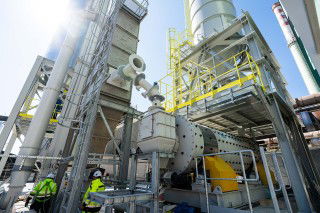This week HeidelbergCement released its 2017 Sustainability Report, describing the publication as an integral part of the group's strategy. Dr Bernd Scheifele, chairman of the Managing Board of HeidelbergCement, said that in 2017, the company has never sold more cement, concrete gravel and sand - record figures were also achieved in revenue and results. However, balancing this achievement with sustainability goals is the only way the company can achieve sustainable corporate governance.
Dr Scheifele further explained that HeidelbergCement's strategy is clear: "to achieve continuous growth, create long-term value for our shareholders, and safeguard high-quality jobs, we must operate on a sustainable basis to remain viable for the future."
Global climate change and emissions control
As part of its commitment to reduce a range of emissions and lower its impacts on global climate change, Heidelbergcement has set several key emissions targets.
Specific emissions of dust per tonne of clinker have been reduced by 71.8 per cent in 2017 when compared with the baseline year of 2008 (target: -80 per cent by 2030).
In addition, the company aims to lower NOx and SOx emissions by 40 per cent by 2030. Last year NOx and SOx emissions were 13.4 and 27.5 per cent, respectively below the reference year of 2008.
In terms of specific net CO2 emissions the company achieved a 18.7 per cent reduction in 2017 when compared with baseline year 1990. It has set a goal of -30 per cent by 2030.
Further measures to reduce the cement producer's carbon footprint include efforts to reduce the clinker content of cement to 70 per cent by 2020. In 2017 the clinker factor reached 75.3 per cent, up slightly from 74.4 per cent in the previous year. In addition, HeidelbergCement plans to increase the share of alternative fuels to 30 per cent of the fuel mix by 2030. Last year the thermal substitution slipped to 20.8 per cent from 21.4 per cent in 2016.
However, it must be mentioned that the incorporation of Italcementi's plants into the HeidelbergCement production base is impacting these indicators and as the new additions are brought in line with HeidelbergCement’s sustainability policies, further improvements can be expected.
Committed to carbon capture
HeidelbergCement remains a committed partner to CO2 capture projects such as the EU-funded Low Emissions Intensity Lime and Cement (LEILAC) project at the Lixhe cement plant and the Norwegian government's Carbon Capture and Storage (CCS) project at the Brevik cement plant where captured CO2 will be transported underground in 2023.
The CEMCAP project is another CO2 capture initiative funded by Horizon 2020EU that will see oxyfuel used on kilns such as the Hanover plant that is testing clinker cooling with CO2 only.
HeidelbergCement also launched CO2Min in 2017 with RWTH Aachen University and the Institute for Advanced Sustainability Studies to research the ability of natural minerals like olivine and basalt to absorb CO2 and produce marketable building materials.
Product development
Of the cement types that HeidelbergCement manufactured in 2017, 40 per cent were ordinary Portland cements, multiple-component cement made up 18.4 per cent, limestone cement accounted for 17.7 per cent, slag cements totalled 13.4 per cent, pozzolan and fly ash cement was 7.5 per cent, GGBS 1.4 per cent, masonry 0.9 per cent and oil well 0.7 per cent.
However, in line with its drive to lower CO2 emissions and reduce energy consumption, the company's innovation and product development is actively engaged in improving current products and creating new mix formulations. A total of EUR141m was therefore spent on research and technology in 2017 by the company, around EUR24m more than in 2016. One of the innovations to be created from this research is Ternocem® which is an alternative clinker technology that has reduced CO2 emissions and promoted energy savings of 15 per cent.
Alternative raw materials
Closely-linked to the improvement and development of the company's products is the use of alternative raw materials in the production of cement. In the reporting period, the proportion of alternative raw materials used in HeidelbergCement's cement production was 11.1 per cent.
Projects include the use of rock flour from local quarries in Africa as an additional component in cement production, replacing imported clinker with local raw materials.
Meanwhile, in The Netherlands, France and Germany, the company is investing projects that use the fines from concrete recycling as a cement ingredient to fully close the loop in concrete recycling.
In the reporting period, the proportion of alternative raw materials used in HeidelbergCement's cement production was 11.1 per cent.
Water wisdom
As the cement industry is becoming increasingly aware of the impact of its water consumption on global water resources, measures are being put in place to lower water use and improve the treatment and recycling of wastewater.
HeidelbergCement aims to significantly reduce its water consumption by 2030. In 2017 its specific water consumption reached 306.5l/t of cement. To date the company has developed the first individual water management plans for cement plants and has introduced key reporting figures for water use in the aggregates and ready-mix concrete segments.
Occupational safety
Occupational safety is also a top priority for the multinational. It has a 2030 goal of 'zero harm'. In 2017 the accident frequency rate in the company's core businesses decreased by 21 per cent. While this represented significant improvement Dr Scheifele reported that serious accidents, including a few fatalities, occurred and the company would continue its efforts towards ‘zero harm’.
